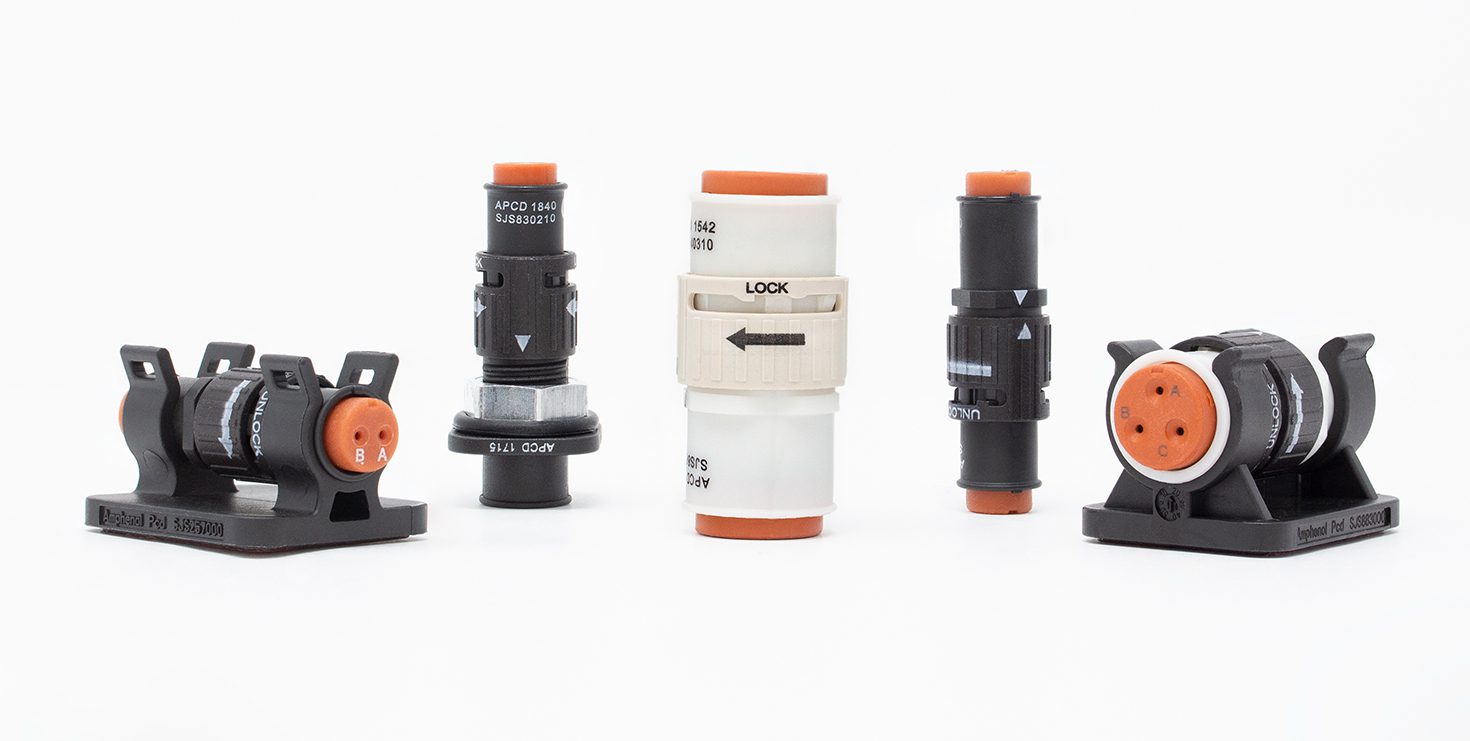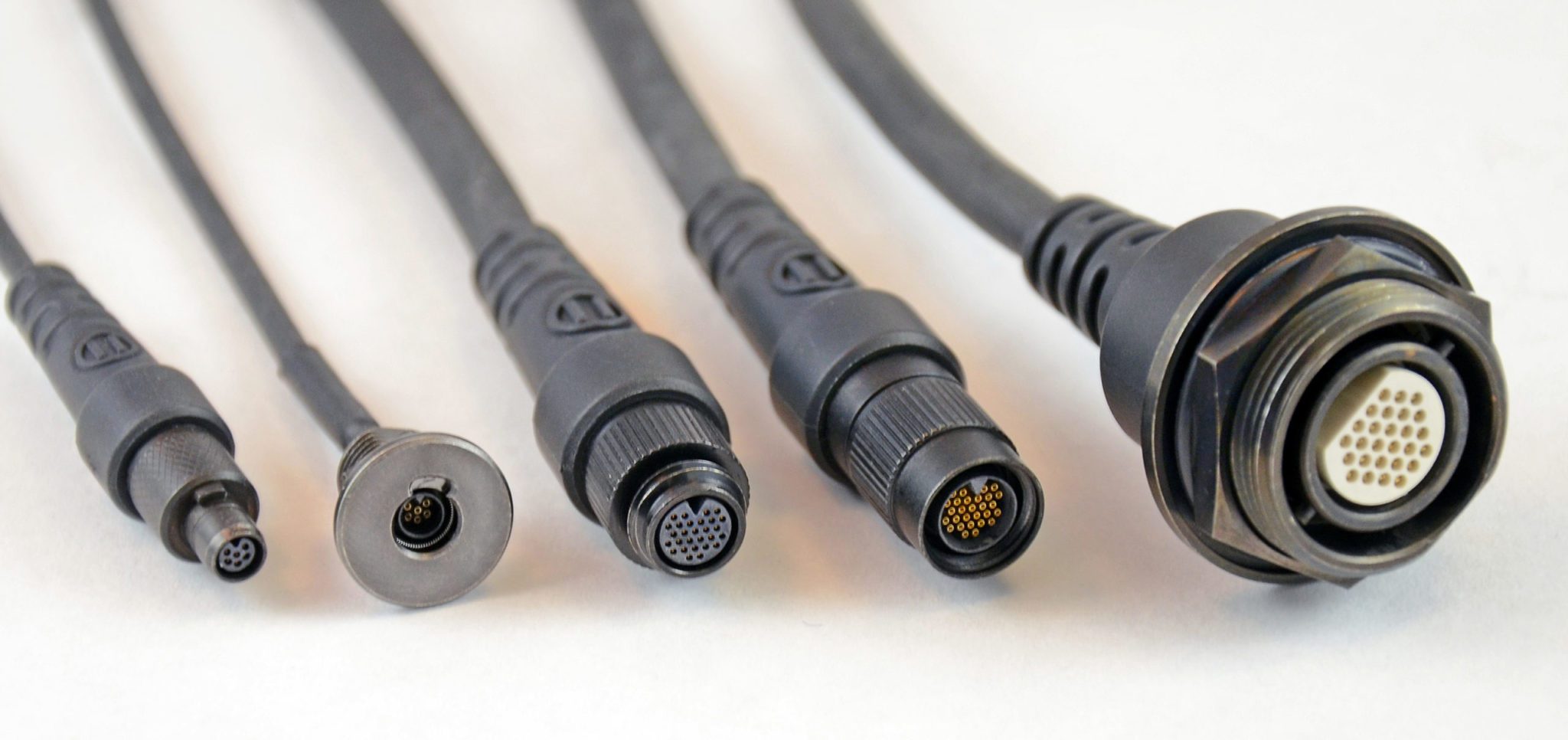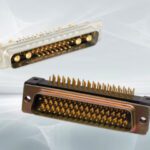The Race to Smaller, Lighter, Faster Aircraft
The small aircraft marketplace is booming and the push to develop fully electric vehicles is driving design changes that are even trickling back to traditional aircraft.
Smaller, lighter, faster — a mantra throughout the electronics industry — certainly applies to the small aircraft market. Growing demand for high-performance, energy-efficient, less-polluting aircraft is propelling the increased development of hybrid and fully electric aircraft, although the technology is currently only within reach for small commuter- or cargo-type planes.

Designers and manufacturers of these small aircraft, which encompass AAM (advanced air mobility) airframes, eVTOL (electric vertical takeoff and landing), and eSTOL (electric short takeoff and landing) aircraft — require new connectivity solutions for the unique challenges these vehicles present. The connector industry is evolving to meet those requirements.
“The needs of electric aircraft are driving the technology and that technology is also being embraced by traditional aircraft manufacturers who are all looking for ways to make their planes lighter and faster,” said Steven Hogan, product manager at Amphenol Pcd. In aircraft, less weight equates to less fuel consumption, whether traditional fuel or electric. This is important with any aircraft, but is especially critical for battery-powered planes, and every gram matters.
When batteries are your fuel
With fuel-based engines, some power created by the engine is distributed throughout the aircraft to enable functions beyond flying the plane. In fully electric aircraft, batteries are the fuel and they have a different way of converting and inverting power to usable levels. An electric aircraft may have 15-25 batteries. The power coming off the battery is high voltage and is converted to lower voltage to accommodate everything from the sensory data coming up to the aircraft (e.g., information on what is around the plane at takeoff and while the plane is in the air, air-to-ground-communication, the status of the battery, GPS, and weather data), as well as data related to the passenger experience, including inflight entertainment and Wi-Fi.
These high voltage connectors need to address a lot of factors. “Flying changes everything,” said Kristina Higgins, business development manager at Amphenol Pcd and an AAM expert. “There is degradation of the electrical current as you fly and the higher you go. Batteries can spark or catch on fire.” Connectors, as well as cables and other components, must be made of low smoke, halogen-free, safe housing material that can withstand the harsh environment of an aircraft in all conditions. Times Microwave Systems is one supplier that offers cable products that meet the exacting requirements of civil aviation.
How connectivity is evolving for this new environment
Connectivity solutions are addressing the constraints of small aircraft with design improvements and material changes. Each component not only has to perform its function reliably, it must do so at altitude while withstanding shock, vibration, and changes in temperature. In addition, it must add as little weight and take up as little space as possible.
Connectors for this market are now made of lightweight plastic or composites, rather than metal. These materials are less brittle and are designed to handle thermal cycling or thermal shock. They require dielectric withstand and altitude immersion testing to ensure reliability and airworthiness when reaching elevations above 12,000 feet. High quality polymer shells and overmolding make them easy to handle and plug in and out.
Size and weight are addressed with miniaturized connectors (e.g., micro and nano pin-and-socket systems). Mixed signal or hybrid connectors have three or four wires instead of one or two to combine power, high-speed digital data, and radio and microwave signals, so fewer connectors are needed.
An electric airplane might have 36 electric motors (fans) to deliver the power and the control. “We see ourselves being successful with higher gauge wire for the power and with our traditional products for the control, whether it be a CAN bus or similar form of communication to all these individual motors,” said Hogan. “The designers are trying to make sure that if one motor fails, the others compensate appropriately. That’s where a lot of connectors are being used in electric aircraft compared to other small aircraft.”
As electric systems replace mechanical systems, wire replaces heavy cables. “The electrics want bigger wires — 12 gauge, and to pull off the battery they want 8 gauge and up to 4 mm contacts,” Hogan added. “And those newer larger gauges are where we’ve been doing a lot of development for new products, just because there is a lot more electricity flowing around the aircraft for either operating it, or lighting it, or for all the various services where connectors are used.”
How connectors and cables are made today also impacts their functionality. The prototyping of small connectors is enhanced with 3D printing. An engineer can request a plastic model that the designer can test in a specific system. 3D printing can also be used to create a flex circuit or to make a cable out of flexible, instead of round, wire, explained Bob Stanton, director of technology at Omnetics Connector Corporation.
One-for-one exchange simplifies change
In an industry that is so highly regulated to ensure safety, changes are not made lightly. Every new component must be well-thought out and proven to be safe and reliable, while balancing high performance with low cost.
An example of this is cable clamps. Thousands of clamps are used in an aircraft to route and secure wire and cable to the structure. Light aircraft is moving away from industry-standard metal clamps to alleviate the heaviness and improve ease of installation, said Randy Gautreaux, system attachment product specialist, Amphenol Pcd. AmphenolPcd’s 75P clamp is a one-for-one drop-in replacement for a standard metal clamp. The band is made of high-performing PEEK (polyether ether ketone) polymer to withstand high temperatures and harsh environments, it reduces the weight by up to 55% from standard metal clamps.
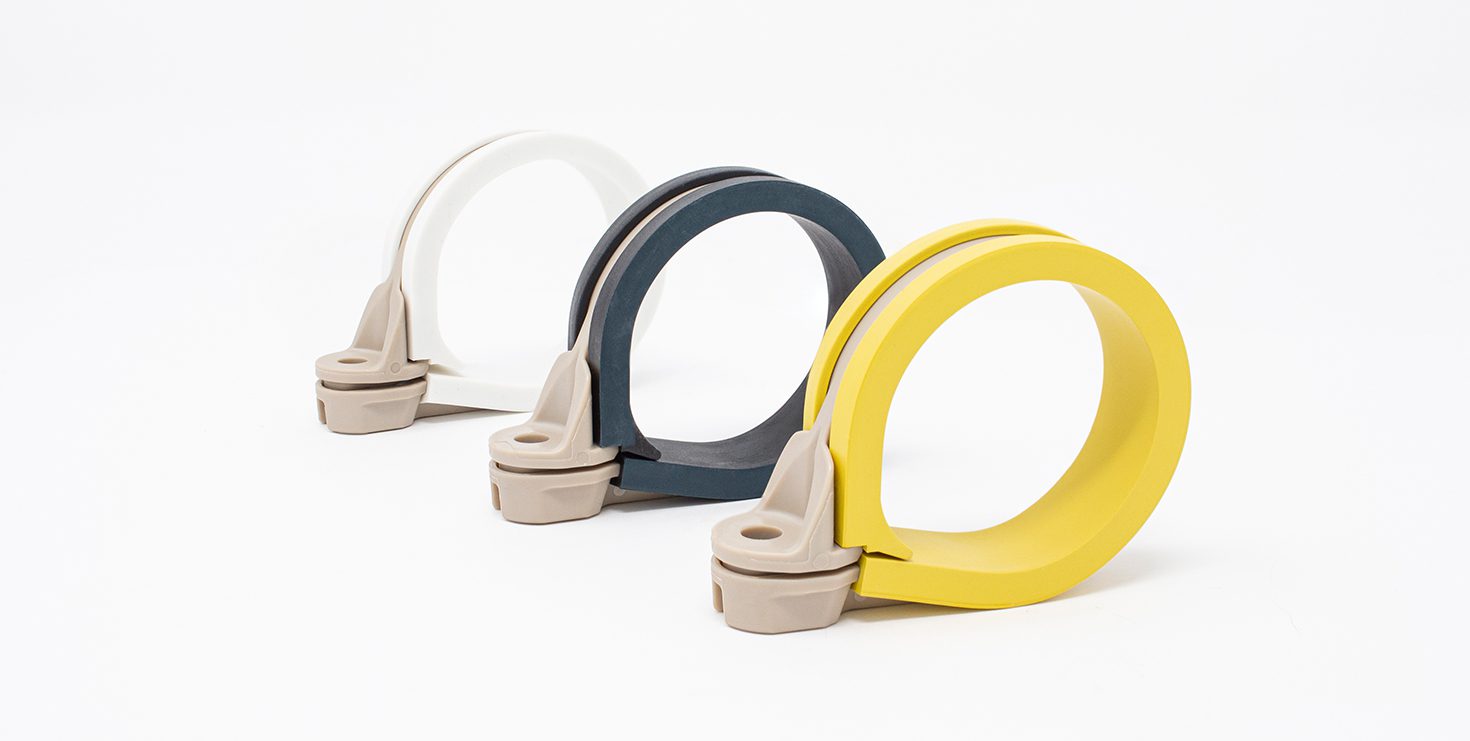
Amphenol Pcd’s 75 P Clamp is a lightweight, one-for-one drop-in replacement for a standard metal clamp.
“The goal is to be able to replace what customers are using with as little pain as possible. In the [aviation] industry, customers are a little resistant to change, especially going from something well-known, like metal, to plastic. Our goal is to make sure that they have all the information necessary to make that change, and to show them the benefits of making that change,” said Gautreaux.
Adhesives lower installation costs and reduce the risk of FOD
To maximize space, cables are routed through partitions and require the installation of feed-throughs, which are typically metal and may be machined. Amphenol Pcd offers conversion from metal to composites, which reduces the weight and injection molding can replace machining, saving time and money.
Clamps also typically require tools, and some form of attachment, such as rivets, to adhere them to the aircraft. All that extra hardware quickly adds up to a significant amount of weight. In addition, AAM manufacturers use lightweight composite structures and want to avoid putting holes in them. This has led to a rise in the use of adhesives, rather than screws. Adhesive standoffs have flat bottoms where two-way tape or wet adhesive is applied, and then they are permanently adhered to the structure.
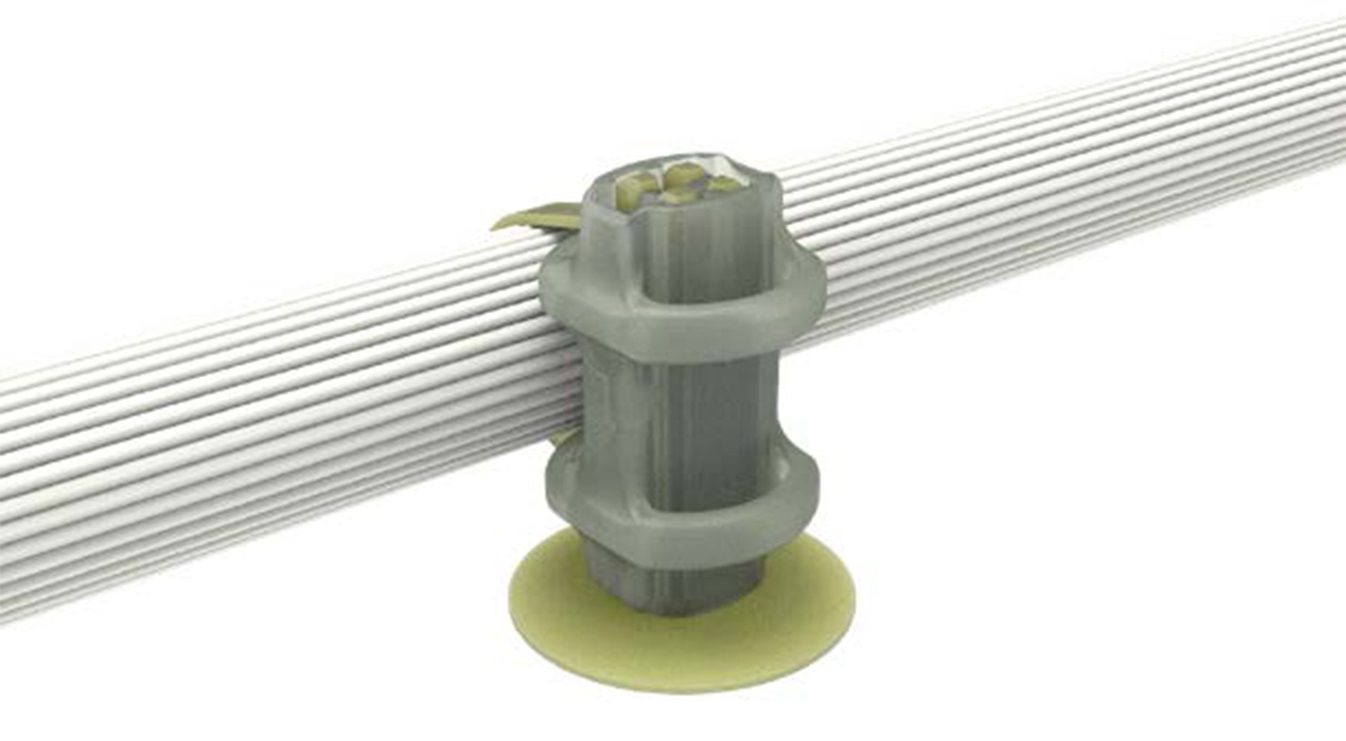
Amphenol Pcd’s Snap ‘N Post is a good example of adhesives used to achieve time and weight savings in electric aircraft.
Another issue with standard clamps is that hardware gets dropped and the plastic tie wraps used to attach the cables break over time. Dropped hardware can also become foreign object debris (FOD), which is a huge hazard.
“You can’t have FOD on an aircraft knocking around loosely. With large hands attaching teeny screws, even if they are being riveted, they can easily be dropped. There are a lot of components that can be lost — washers, screws, nuts, and bolts,” said Higgins. Because of the shock and vibration in an aircraft, FOD can also get caught inside a connector or PCB and interfere with its operation. Adhesives lessen the cost of install by eliminating the risk of FOD.
Fully electric planes are not yet operating on a regular basis. Battery technology still needs to overcome size and weight challenges, and the battery-powered aircraft now in use or in development are limited to smaller size and shorter runs. Even as planes become smaller and lighter, and batteries last longer, aircraft will still require a significant amount of redundancy to meet rigorous safety standards, so if something does fail a backup system can seamlessly take its place. Weight will continue to be factor and airframe designers and manufacturers will continue trying to get the maximum distance or speed out of their vehicles.
- Mezzanine Connectors Product Roundup - April 16, 2024
- Out Now! New eBook Shares Bright Ideas for Electrification - April 16, 2024
- What are ARINC 801 Connectors? - April 9, 2024
